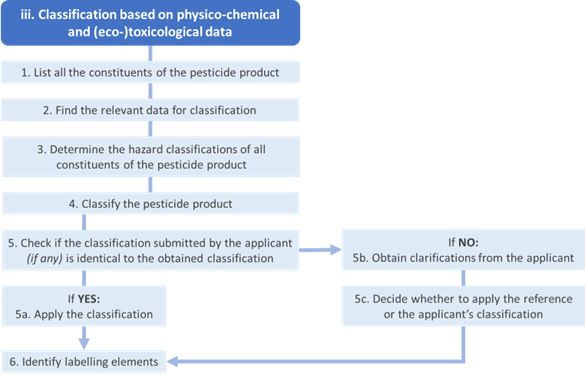Classification based on physico-chemical and (eco-)toxicological data * (B3)
In this approach, the Registration Authority obtains the relevant physical and (eco-)toxicological data needed to classify the pesticide product and/or its constituents, either from the registration dossier submitted by the applicant or from reputable other sources. It then identifies the hazard categories for the various hazard classes, by comparing these data with the GHS hazard classification criteria. This approach is relatively complex and time-consuming, since physical and (eco-)toxicological studies need to be evaluated, appropriate endpoints of those studies identified, and compared to the GHS classification criteria for each of the hazard classes. However, it is also the most precise GHS classification of a given pesticide product, based on the data that are available for the specific pesticide product under review.
 The assessment process to be followed is summarized in the flow chart below.
The assessment process to be followed is summarized in the flow chart below.

Step 1. List all the constituents of the pesticide product
List all the constituents of the pesticide product, i.e. active ingredient(s) and co-formulants, as well as their concentrations. In principle, all co-formulants are relevant – and therefore need to be classified – if their concentration exceeds the cut-off values/concentration limit for each specific hazard.Step 2. Find the relevant data for classification
2.1 Compile the relevant data for classification. Data could either come from tests conducted with the formulation (quite common for the acute toxicity) or with the active ingredient (usually the case for the chronic toxicity and environmental hazards).
The data needed to be able to classify the pesticide are listed for Physical Hazards {INSERTLINK to Page D1}, Health Hazards {INSERTLINK to Page D2} and Environmental Hazards {INSERTLINK to Page D3}.
2.2 Toxicity data supplied by the applicant in the pesticide registration dossier may be compared with validated (inter)national data available from reputable sources (use the Scientific Reviews section or Pesticide Properties section of the Information Sources module in the Toolkit)
You can use the GHS Classification Summary Table {INSERTLINK to table} to facilitate the compilation of the necessary data.
Step 3. Determine the hazard classifications of all constituents of the pesticide product
Each hazard is then classified for each relevant constituent of the product, by comparison of the data with GHS hazard classification criteria. If the product does not meet any of the criteria for a specific hazard, no classification of that hazard is necessary. More information about the GHS classification of different types of hazards is provided elsewhere.- Classification of Physical Hazards [D1]
- Classification of Health Hazards [D2]
- Classification of Environmental Hazards [D3]
